Please Take Note: This is a review of the final game, but it might change slightly based on the success of the Kickstarter campaign. The game is being reviewed on the components and the rules provided with the understanding that “what you see is not what you might get” when the game is published. If you like what you read and want to learn more, we encourage you to visit the game publisher’s website or visit the Kickstarter campaign. Now that we have all that disclaimer junk out of the way, on with the review.
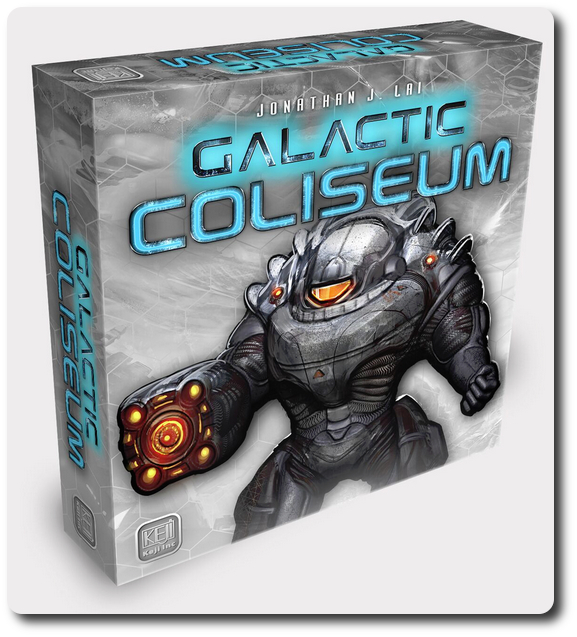
The Basics:
- For ages 8 and up (publisher suggests 14+)
- For 2 to 4 players
- Approximately 45 minutes to complete
Geek Skills:
- Counting & Math
- Logical & Critical Decision Making
- Reading
- Pattern/Color Matching
- Strategy & Tactics
- Visuospatial Skills
- Hand/Resource Management
- Area Control
Learning Curve:
- Child – Easy
- Adult – Easy
Theme & Narrative:
- Fight (sort of) to survive
Endorsements:
- Gamer Geek mixed!
- Parent Geek approved!
- Child Geek approved!
Overview
Crime and punishment are now an opportunity for great ratings and entertainment for the masses. You have been accused of a crime and the only sentence is time in the coliseum. You must fight or die. Win and you survive another day. Lose and you become just one more statistic. You will never be free, but you can now die on your own terms. In a way, that is a kind of freedom that many will never have.
Galactic Coliseum, designed by Jeff Lai and to be published by KEJI Inc, will reportedly be comprised of 1 game board, 2 Barrack mats, 1 Nexus mat, 4 Gladiator mats, 4 Gladiator miniatures, 46 Enemy miniatures, 12 Siphon gems, 12 Gold cubes, 60 Portal tiles (15 per player color), 45 Power cubes (in 5 different colors, 9 per color), 35 Beta tokens, 16 Alpha tokens, 28 Gladiator Ability cards, 10 Coliseum cards, 1 Score pad, and 1 Discard bag. Not included is a pen or pencil to record values on the score pad. As this is a review of a prepublished game, I cannot comment on the game component quality.
Prepare the Coliseum!
To set up the game, first place the game board in the middle of the playing area and within easy reach of all the players. Place a face-down Beta token on all 35 “zones” (large spaces on the game board). No tokens are places on the “Start Zone” located in Stage 1 of the coliseum.
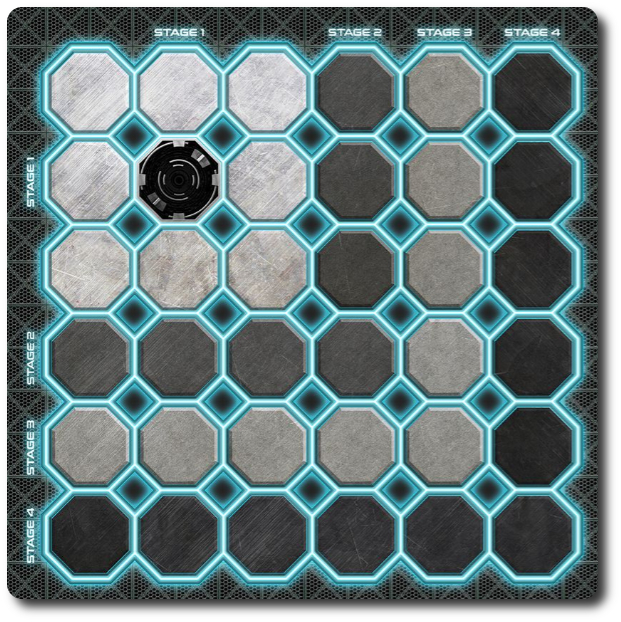 Second, place 1 face-down Alpha token on top of all the Beta tokens in the 11 zones located in Stage 4 of the coliseum.
Second, place 1 face-down Alpha token on top of all the Beta tokens in the 11 zones located in Stage 4 of the coliseum.
Third, choose 1 Coliseum card or shuffle and randomly select one. The Coliseum card determines the starting locations of the Gold cubes and any remaining Alpha tokens. Place the Alpha tokens and Gold cubes now and then discard the Coliseum card.
Fourth, have each player select a Gladiator mat and matching Gladiator miniatures, taking the corresponding Gladiator Ability cards or randomly assign each player 1 Gladiator.
Fifth, place all Power cubes in the Discard bag and mix them together. Draw 3 cubes per colored space on the Nexus board. Continue to draw cubes until there are no more cubes left in the Discard bag. Place the Discard bag to the side of the game playing area.
Sixth, hand out a number of Gladiator tiles to each player based on the number of players in the game. These tiles go on the player’s Gladiator mat for now. Any remaining Gladiator tiles not used are returned to the game box.
Seventh, place the Barracks mat to one side of the game playing area and then place the Enemy miniatures on the matching spaces. Separate the enemies into 4 distinct groups.
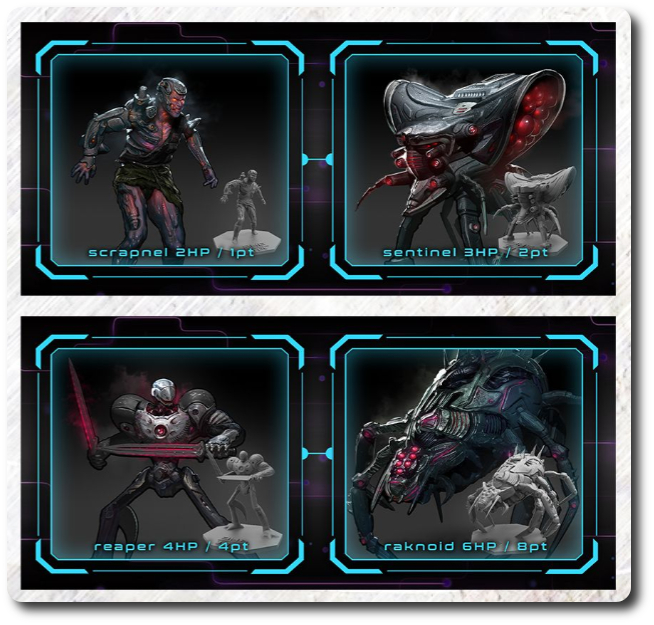 Eighth, have each player select a space and then place their Gladiator miniatures in one of the empty spaces of the “Start Zone”.
Eighth, have each player select a space and then place their Gladiator miniatures in one of the empty spaces of the “Start Zone”.
Ninth, have each player shuffle their Gladiator Ability cards and then draw 5, keeping the drawn cards invisible to the player’s opponent’s at all times until played. Place these cards face-down and to one side of the player’s Gladiator mat. These cards will come into play until Stage 4. Then the player selects 3 of the remaining cards to keep for immediate use and discards the rest.
That’s it for game set up. Time to test your might and ability to survive.
Enter the Coliseum…
Galactic Coliseum is played in stages and turns. A stage and single game turn is summarized here.
At the Start of Each Stage
There are a total of 4 Stages in the game. Each Stage increases the number of spaces in the coliseum, the enemies to fight, and the room to maneuver. At the start of the game, the Gladiators are fairly even matched (one might even say they have a clear advantage) over the coliseum Enemies. As the game progresses, this advantage will quickly disappear.
Step 1: Select Starting Player
Randomly select who will go first for the Stage.
Step 2: Reveal Enemies
Flip all the Beta tokens face-up in the current Stage. Place 1 Enemy miniature per token that matches the Beta token and type. If the Beta token has the word “None” on it, remove it from play.
On a Player’s Turn
Now that the stage is set, the player has to survive. A player’s turn consists of 3 possible actions, but only 1 action can be taken each turn.
Action Option 1: Power-Up
The player can take 1 set of 3 cubes from the Nexus, adding them to their own Gladiator mat. These cubes are added to the player’s cube pool and can be used as soon as the player likes on their next and subsequent turns.
Action Option 2: Move & Attack
A player may move into any adjacent (but not diagonal) space next to their Gladiator miniature, but doing so will cost them 1 Power gem of any color. Discarded Power gems are placed in the Discard bag. Players can move through spaces occupied by Enemy and opponent miniatures, but movement must be paid in full.
Combat is done by discarding a number of Power gems that match the Enemy’s color and hit points. A green Enemy with 3 hit points, for example, would require the player to use 3 green Power cubes. If the Enemy is grey, the player may use any color they like, but all Power cubes must be the same color.
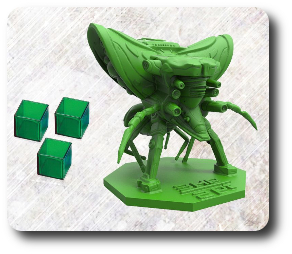
If a particular space has multiple Enemy miniatures, the player can only attack if they have the ability to eradicate all the enemies that currently occupy it.
After a player clears a space of Enemies, they can move into it. Any Golden cubes and Enemy miniatures that occupied it are kept as trophies. The player then places 1 Portal tile on that zone, indicating they claimed it. If the space is already empty, but does not have a Portal tile, the player may claim it for free.
Finally, a player can move and attack multiple times during their turn if they have the Power cubes to pay for the actions. This means the player can move, attack, and then move again or attack 3 times and then move to another space.
Option 3: Siphon, Move & Attack
This is almost identical to Action Option 2, except the player uses 1 of their available Siphon gems to steal a maximum of 2 Power cubes from an opponent. The stolen Power cubes must be the same color and only 1 Siphon gem can be used per turn. Once used, the Siphon gem is discarded to the Nexus mat.
Afterwards, the player can then move and attack if they like.
Reveal a New Stage
When only 1 set of Power cubes remains on the Nexus mat, a new Stage is revealed. New Power cubes are places on the empty Nexus spaces, 1 Siphon gem is given to each player (during Stage 1, 2, and 3), and new Enemy miniatures spawn by flipping over face-down Alpha and Beta tokens.
The Final Battle
After Stage 4 begins, players can turn in their Enemy miniature trophies for 1 Power cube of the same color. If the Enemy miniature is grey, the player may use it to represent any Power cube color. Gladiator Ability cards that were locked during the game now come into play, as well.
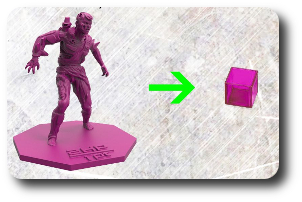
And the Winner Is…
The endgame is triggered when a player has exhausted all their Power tiles by placing them on the game board. The current round is then completed, giving players one last chance to push their limits.
Victory is determined by scoring Kill points (based on the strength of the enemy) and Bonus points. Bonus points are earned by those players who have the most Alpha, Beta, Gold cubes, and Portal tile connections. The Score pad that comes with the game will assist the players in keeping track of scores.
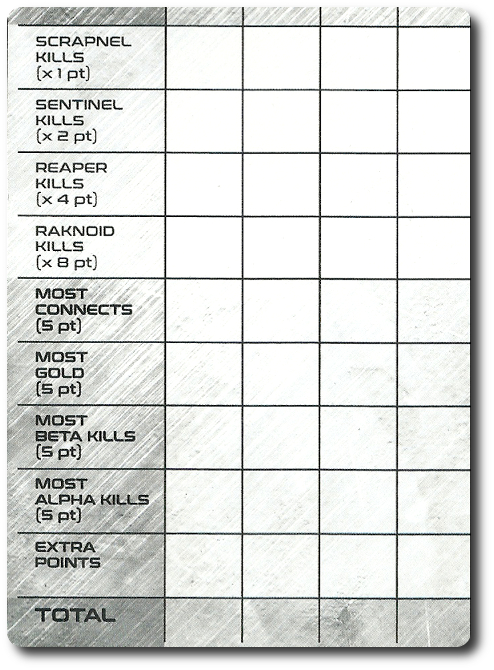
The player with the highest total points wins the game. All others lose their Gladiator to a messy death.
To learn more about Galactic Coliseum, visit the game publisher’s website or visit the Kickstarter campaign.
Final Word
 The Child Geeks really liked the fact that they were in the driver’s seat from the very start. Since the game uses resources to move and attack, the Child Geeks new at all times what they could and could not do. In addition, they also knew what their opponents were capable of, since all Power cubes are visible at all times. According to one Child Geek, “The best part of this game is doing chain kills. I love being able to move, kill, move, and kill again. Lots of points!” The term “chain kill” is never once used in the game, but was instead coined by the Child Geeks after one of them, having collected just about every Power cube in the game, practically cleared the game board. It was epic. Another Child Geek said, “I don’t think there is much combat in the game, but I like that I don’t have to worry about the dice ruining my ideas.” Lack of luck meant the Child Geeks knew the outcome of their possible actions before they even took them, freeing them up from worrying and empowering them to take action. When the games were over, the Child Geeks voted to approve Galactic Coliseum.
The Child Geeks really liked the fact that they were in the driver’s seat from the very start. Since the game uses resources to move and attack, the Child Geeks new at all times what they could and could not do. In addition, they also knew what their opponents were capable of, since all Power cubes are visible at all times. According to one Child Geek, “The best part of this game is doing chain kills. I love being able to move, kill, move, and kill again. Lots of points!” The term “chain kill” is never once used in the game, but was instead coined by the Child Geeks after one of them, having collected just about every Power cube in the game, practically cleared the game board. It was epic. Another Child Geek said, “I don’t think there is much combat in the game, but I like that I don’t have to worry about the dice ruining my ideas.” Lack of luck meant the Child Geeks knew the outcome of their possible actions before they even took them, freeing them up from worrying and empowering them to take action. When the games were over, the Child Geeks voted to approve Galactic Coliseum.
 The Parent Geeks also liked the game, especially since they did not have to attack or be attacked by their children. According to one Parent Geek, “I don’t mind combat games in the slightest, but I never much like having to attack my kids in a game. Feels wrong. Not the case here. This game is more of a race than anything else. And if I steal a kill before my son, I don’t feel bad. Well, I feel bad, but in a good way.” Another Parent Geek said, “I find the game to be very math driven, but not the kind of difficult math that causes a game to slow down. I really like the game’s pace and how quickly outcomes are resolved. My only complaint is the stealing of cubes since cubes are everything in this game.” The only other aspect of the game that the Parent Geeks didn’t care for were the Gladiator Ability cards which felt more like a second thought than a primary component. Many of the Parent Geeks felt like the game could be played without them just fine, but they were still used and enjoyed. When the games were over, the Parent Geeks voted to approve Galactic Coliseum.
The Parent Geeks also liked the game, especially since they did not have to attack or be attacked by their children. According to one Parent Geek, “I don’t mind combat games in the slightest, but I never much like having to attack my kids in a game. Feels wrong. Not the case here. This game is more of a race than anything else. And if I steal a kill before my son, I don’t feel bad. Well, I feel bad, but in a good way.” Another Parent Geek said, “I find the game to be very math driven, but not the kind of difficult math that causes a game to slow down. I really like the game’s pace and how quickly outcomes are resolved. My only complaint is the stealing of cubes since cubes are everything in this game.” The only other aspect of the game that the Parent Geeks didn’t care for were the Gladiator Ability cards which felt more like a second thought than a primary component. Many of the Parent Geeks felt like the game could be played without them just fine, but they were still used and enjoyed. When the games were over, the Parent Geeks voted to approve Galactic Coliseum.
 The Gamer Geeks didn’t think Galactic Coliseum was a combat game in the slightest. While they did very much like that fact that luck was out of the game, they couldn’t imagine a combat game without risk. And since Galactic Coliseum has no risk, they were perplexed. According to one Gamer Geek, “This is an odd game. It visually comes across as a combat game with miniatures and grid movement, but the actual combat aspect of it is not there. I essentially pay to remove enemies. I don’t attack them, I don’t maul them, I don’t do anything other than hand over cubes. That’s not combat. That’s commerce.” But some of the Gamer Geeks found this type of combat refreshing. According to one Gamer Geek, “I like how the game focuses more on building momentum and taking queues from other players rather than focusing on the luck of dice rolls. I also really enjoy how quickly the game is played.” When the votes were in, the Gamer Geeks gave Galactic Coliseum a mixed vote of approval.
The Gamer Geeks didn’t think Galactic Coliseum was a combat game in the slightest. While they did very much like that fact that luck was out of the game, they couldn’t imagine a combat game without risk. And since Galactic Coliseum has no risk, they were perplexed. According to one Gamer Geek, “This is an odd game. It visually comes across as a combat game with miniatures and grid movement, but the actual combat aspect of it is not there. I essentially pay to remove enemies. I don’t attack them, I don’t maul them, I don’t do anything other than hand over cubes. That’s not combat. That’s commerce.” But some of the Gamer Geeks found this type of combat refreshing. According to one Gamer Geek, “I like how the game focuses more on building momentum and taking queues from other players rather than focusing on the luck of dice rolls. I also really enjoy how quickly the game is played.” When the votes were in, the Gamer Geeks gave Galactic Coliseum a mixed vote of approval.
 Galactic Coliseum is very resource driven. No luck is involved, unless you count the Gladiator Ability card draws as “luck” in the beginning of the game. Everything else is completely in the player’s hands, which is both a good and a bad thing. Good in the sense that the player has complete control over what they want to do and when. They can spend their resources the way they choose and they know the outcome of their use before they even consider spending them. This greatly empowers the player and challenges them to consider the best possible and productive way to victory.
Galactic Coliseum is very resource driven. No luck is involved, unless you count the Gladiator Ability card draws as “luck” in the beginning of the game. Everything else is completely in the player’s hands, which is both a good and a bad thing. Good in the sense that the player has complete control over what they want to do and when. They can spend their resources the way they choose and they know the outcome of their use before they even consider spending them. This greatly empowers the player and challenges them to consider the best possible and productive way to victory.
On the flip side, with so much on the player’s shoulders, little is offered in the ways of support. There will be several turns where the player can do little but collect Power cubes, which is not necessarily a bad thing, but it does cause the game’s level of excitement to drop. A number of players commented that Galactic Coliseum felt more like a math game than a combat game. I liken it to more of a Euro-game, myself. There is no real combat, but there can be a great deal of conflict. Mostly, however, the conflict is in the player’s mind as they attempt to determine what is the best approach to victory and how best to use their turn.
Player interaction is minimal, but present. Siphon gems are a nuisance, but never more than an irritation. They perhaps represent the best possible example of “players attacking players”, as they are sabotaging possible actions. Everything else is based on interaction with the game board and racing to certain spots to claim prizes. Since the player’s Gladiator can never get hurt and the outcome of a “battle” is always clear before it even starts, the overall game play is reduced to logical and critical thinking instead of risk taking. Which is not to say players can’t make some very poor decisions, but these only come to light after the fact due to the perfect 20/20 vision that hindsight provides.
Overall, I found Galactic Coliseum to be so-so. I didn’t feel much in the way of excitement, but I did enjoy the way it made me think and ponder my future moves. Lack of luck is always a good thing, but in this case, lack of random outcomes made the game feel more mathy than it needed to be. The excitement of fictionally swinging a laser sword is replaced by shifting cubes around. Not my kind of thing, but it certainly appealed to many of our players. If you enjoy games where the outcome is based on logical thinking, critical analysis, and productive game play, then do play Galactic Coliseum. What it lacks in action it more than makes up for in resource management.
This is a paid for review of the game’s final prototype. Although our time and focus was financially compensated, our words are our own. We’d need at least 10 million dollars before we started saying what other people wanted. Such is the statuesque and legendary integrity of Father Geek which cannot be bought except by those who own their own private islands and small countries.



